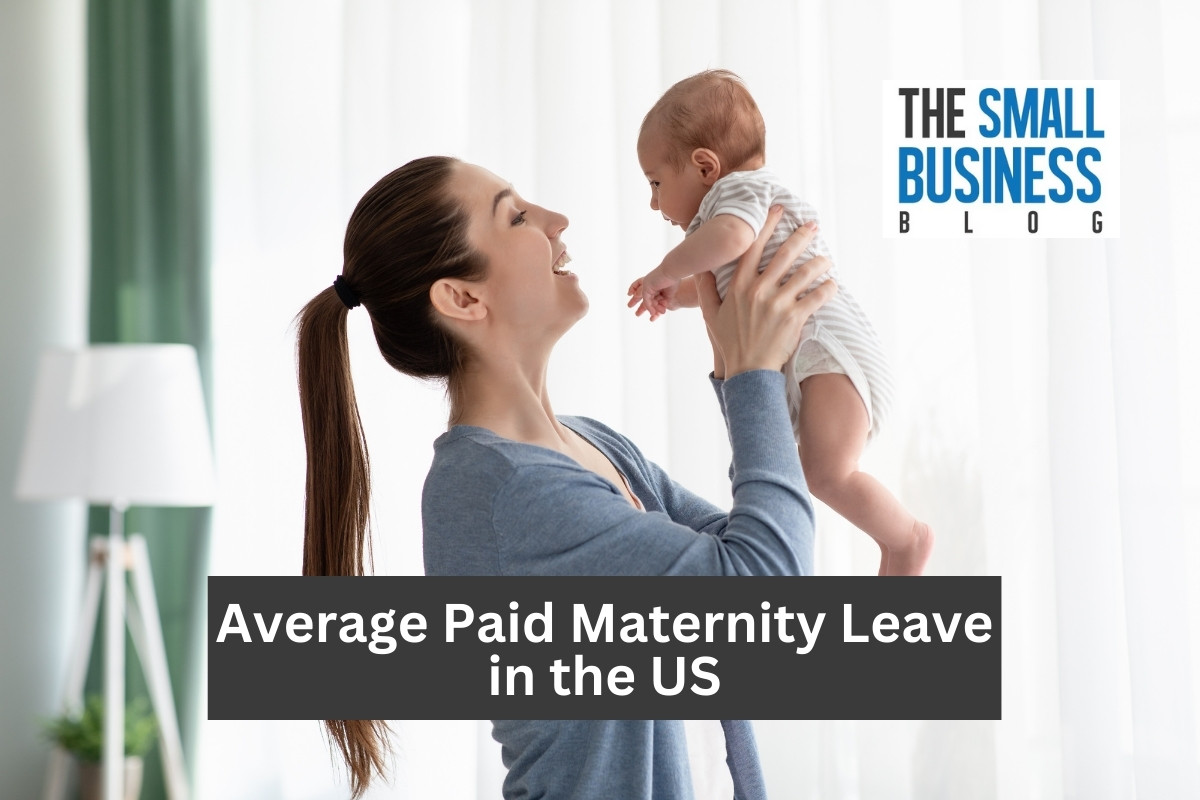The average paid maternity leave in the United States is only eight weeks, which is quite the gap compared to the global standard of 18 weeks.
This data shows how this leaves new mothers facing the challenge of taking care of their health and the health of their newborn and their financial security.
The lack of sufficient paid maternity leave in the United States not only adversely affects mothers, but their families and the nation’s whole economy.
In this resource, we will be sharing the average paid maternity leave in the US, but also how that compares with other countries.
Post Contents
- 1 Key Statistics
- 2 Average paid maternity leave in the US in 2024
- 2.1 1. Only 27% of employees receive paid family leave in 2023.
- 2.2 2. 8 weeks is the average maternity leave time for paid maternity leave in the United States.
- 2.3 3. Only 16% of American employees take1 to 4 weeks of maternity leave.
- 2.4 4. Deloitte gives 120 days of maternity leave to new mothers.
- 2.5 5. Only 13% of women in the private sector have access to any paid maternity leave.
- 2.6 6. Bulgaria offers the longest maternity leave in the world at 58.6 weeks.
- 2.7 7. Estonia allows up to 20 weeks of paid maternity leave to new mothers.
- 2.8 8. The United States doesn’t even make the top 10 in maternity leaves.
- 2.9 9. 80% of American workers have no paid time off for the birth or adoption of a child.
- 2.10 10. The FMLA is a law that requires covered employers to provide at least 12 weeks of unpaid maternity leave.
- 2.11 11. $1,140.66 per week is the average maximum paid maternity leave
- 2.12 12. Mississippi is ranked the worst state for paid family leave.
- 2.13 13. Black and Latino employees are less apt to have access to paid maternity leave.
- 2.14 14. In Bulgaria, paid maternity leave is 90% of the employee’s income.
- 2.15 15. High wage earners are 10 times more apt to have access to paid maternity leave.
- 2.16 16. Between 2013 and 2022 paid maternity leave doubled.
- 2.17 17. Expert recommendations say that paid maternity leave needs to be at least six months.
- 2.18 18. UNICEF recommends that parents should have 24 weeks (6 months) of paid family leave.
- 2.19 19. NVIDIA also deserves kudos for their paid maternity policies.
- 2.20 20. 40% of women aren’t eligible for the FMLA.
- 3 FAQs
- 4 Conclusion
Key Statistics
- Only 27% of employees receive paid family leave in 2023.
- 8 weeks is the average maternity leave time for paid maternity leave in the United States.
- Only 16% of American employees have access to 1 to 4 weeks of maternity leave.
- Deloitte gives 120 days of maternity leave to new mothers.
- Only 13% of women in the private sector have access to any paid maternity leave.
- Bulgaria offers the longest maternity leave in the world at 58.6 weeks.
- Estonia allows up to 20 weeks of paid maternity leave to new mothers.
- The United States doesn’t even make the top 10 in maternity leaves.
- 80% of American workers have no paid time off for the birth or adoption of a child.
- The FMLA is a law that requires covered employers to provide at least 12 weeks of unpaid maternity leave.
Average paid maternity leave in the US in 2024
1. Only 27% of employees receive paid family leave in 2023.

Unfortunately, only 27% of U.S. companies offer paid family leave for new mothers or fathers in 2023.
Though this figure is up by 3% over 2022 (24%), it still shows slow growth in a much-needed realm of paid leave.
The growth has been gradual, but present since 2018 (16%).
In 2020, 20% of workers had access to paid family leave in the United States.
(New America)
2. 8 weeks is the average maternity leave time for paid maternity leave in the United States.
Overall, maternity leave in the United States for workers comes to an average of only 8 weeks and in some cases only 6 weeks.
This is barely enough time to adjust to the new family dynamic much less recovery and healing from giving birth.
(Zippia)
3. Only 16% of American employees take1 to 4 weeks of maternity leave.
Even at the lowest paid maternity leave of one to four weeks, only 16% of American workers take those benefits.
Overall, only 51% of women take at least five or more weeks for maternity leave.
This ranges from 1 to 4 weeks (16%) to 5 to 9 weeks (26%).
Moreover, 33% take zero maternity leave.
(Zippia)
4. Deloitte gives 120 days of maternity leave to new mothers.
In the United States, Deloitte is an outlier in terms of providing the longest amount of paid maternity leave for new mothers.
They also offer 80 paid paternity leave for new fathers.
This means that Deloitte gives new mothers four months of paid maternity leave, which is significantly more generous than most U.S. based companies.
(Great Place to Work)
5. Only 13% of women in the private sector have access to any paid maternity leave.

2016 statistics from the Bureau of Labor Statistics show that only 13% of women have access to any kind of paid maternity leave in the United States in the private sector.
Private sector jobs are non-government jobs like manufacturing, professions, financial services, hospitality, etc.
(Shortlister)
6. Bulgaria offers the longest maternity leave in the world at 58.6 weeks.
Grant it, this may not be all paid maternity leave, but it is a lengthy amount of leave for new mothers.
This is equal to over a year of maternity leave.
It’s unclear how much, if any, is paid.
(World Population Review)
7. Estonia allows up to 20 weeks of paid maternity leave to new mothers.
Estonia is a country in Northern Europe that allows up to 20 weeks of paid maternity leave for its new mothers.
Compared to the average of six to eight weeks in the United States, this is a very generous maternity leave policy.
This data is to show the difference between the United States and other nations.
(World Population Review)
8. The United States doesn’t even make the top 10 in maternity leaves.
How does the United States compare among nations in the world in terms of maternity leaves?
The United States allows for an average of eight weeks of paid maternity leave and the FMLA allows for 12 (not all paid) if the mother is eligible.
However, the U.S. doesn’t make the top 10 in the world in maternity leaves.
While they are not all paid maternity leaves, Bulgaria (58.6 weeks), Greece (43) weeks, UK (39 weeks), and Slovakia (34 weeks) are the top four in the world.
(World Population Review)
9. 80% of American workers have no paid time off for the birth or adoption of a child.
We now have an idea of how the U.S. compares to other countries in terms of paid maternity leave, but what about Americans that have no paid or unpaid maternity leave?
A whopping 80% of U.S. employees have no access to paid time off after the birth or adoption of a child.
The United States has no national policy for paid leave for workers at all, much less maternity leave.
(National Partnership for Women & Families)
10. The FMLA is a law that requires covered employers to provide at least 12 weeks of unpaid maternity leave.

In the United States, there is only one law that addresses any kind of maternity leave.
That law is the FMLA (Family and Medical Leave Act) and it only states that covered employers must provide at least 12 weeks of unpaid maternity leave, not paid.
The actual minimum required paid maternity leave in the United States is “0” weeks.
(World Population Review)
11. $1,140.66 per week is the average maximum paid maternity leave
In the United States the average paid maternity leave payment maxes out at $1,140.66 per week.
That is only among the states that offer paid maternity leave.
As mentioned there is no federal law about paid maternity leave as it’s left to the individual states to manage that.
(Annuity)
12. Mississippi is ranked the worst state for paid family leave.
We’ve somewhat discussed that the individual states are responsible for handling rules, regulations, and law regarding paid maternity leave in America.
Mississippi happens to be the worst state for paid family leave with no legal protections for employees.
(Annuity)
13. Black and Latino employees are less apt to have access to paid maternity leave.
There is a racial and ethnic disparity in access to any kind of paid leave in the American workplace.
White employees are more likely to have access to paid maternity or family leave than Black and Latino employees.
(National Partnership for Women & Families)
14. In Bulgaria, paid maternity leave is 90% of the employee’s income.
Bulgaria has maternity leave laws in place to protect new mothers and families.
In fact, the paid maternity leave is 90% of the employee’s regular income, which is generous.
Paternity leave in Bulgaria offers the same compensation.
(World Population Review)
15. High wage earners are 10 times more apt to have access to paid maternity leave.

In the private job sector, the highest wage earners are 10 times more likely to have access to paid family/maternity leave.
So, besides racial and ethnic disparities, there are also disparities among wage earners and paid maternity leave.
In fact, 51% of top wage earners had access to maternity benefits in the Q4 of 2023.
(New America)
16. Between 2013 and 2022 paid maternity leave doubled.
Some progress has been made in paid family leave in America since 2013.
In 2013, only 12% of American workers had access to any kind of paid family leave compared to the 25% in 2022.
While that means the numbers more than doubled, there are still around three-quarters of workers in America without access to paid family leave.
(USNews)
17. Expert recommendations say that paid maternity leave needs to be at least six months.
According to experts, paid maternity leave should be at least six months, but one year is better.
Therefore, U.S. lawmakers on every side of the aisle suggesting that 12 unpaid weeks is progress is of no real effect.
(Zippia)
18. UNICEF recommends that parents should have 24 weeks (6 months) of paid family leave.
Experts aren’t the only ones who think six months is a good paid maternity leave policy.
UNICEF, a global agency that provides children with in desperate need lifesaving supplies and assistance, also recommends at least 24 weeks (6 months) of paid maternity/family leave.
(Great Place to Work)
19. NVIDIA also deserves kudos for their paid maternity policies.
NVIDIA, a tech company, offers 110 days of paid maternity leave and 80 days of paid paternity leave.
This company deserves a round of applause as does Deloitte for supporting their employees and their families when they need it the most.
(Great Place to Work)
20. 40% of women aren’t eligible for the FMLA.

Even though the FMLA is designed to protect employees from job loss due to having to take time off like after having a baby, 40% of women don’t qualify for it.
For those who do qualify for it, they can get 12 weeks of unpaid leave.
(Shortlister)
FAQs
How long is maternity leave in America?
As mentioned in the article, paid maternity leave in American businesses averages only six to eight weeks across industries.
While many new mothers require more healing time, they aren’t getting paid past the six to eight weeks allowed.
For some, they are losing their jobs when they can’t return to work that soon.
What is FMLA?
FMLA is the Family and Medical Leave Act, which is a federal law in the United States that allows some job protection for those who require up to 12 weeks of unpaid maternity leave.
While this may protect their jobs to some extent, it doesn’t include paid maternity leave during this time, businesses don’t have to pay them even when it’s an avoidable situation.
Which states in the U.S. offer paid maternity leave?
While many businesses all over the country offer paid maternity leave, not all 50 states of the United States have paid maternity leave regulations.
Here is the list of those that do:
1. California
2. Connecticut
3. Delaware
4. Hawaii
5. Maine
6. Massachusetts
7. Maryland
8. Nevada
9. New Jersey
10. New York
11. Oregon
12. Rhode Island
13. Virginia
14. Washington, DC
This list is all the states that offer paid maternity leave.
Otherwise, it’s left to the discretion of the business.
What is the impact of paid maternity leave?
Here are some challenges of paid maternity leave:
1. The costs incurred form paid leave
2. The administrative burden of managing paid leave
3. The potential for discrimination in the workplace
What is the future of paid maternity leave?
The future of paid maternity leave in the United States is uncertain.
However, support is growing in paid maternity leave where several states and companies are taking steps to expand their paid leave policies.
Conclusion
We can see from these statistics that the United States falls way behind even smaller countries in terms of having protections in place for families for paid family leave.
Even the 12 weeks of unpaid leave under the FMLA is a poor protection ideal.
One thing to understand about the United States is that the federal government usually stays out of state business.
Most of the laws regarding the workplace and businesses are the responsibility of each individual state.
That said, each state in the United States should consider the expert recommendations for maternity leave.
What’s left is that some US-based companies like Deloitte, NVIDIA, Cisco, and others are making better paid family leave policies for their employees.
Hopefully, this will become a growing trend in America.
We hope that knowing the average paid maternity leave in the US and other factors that it impacts helps to enlighten you while bringing awareness to this issue.






























